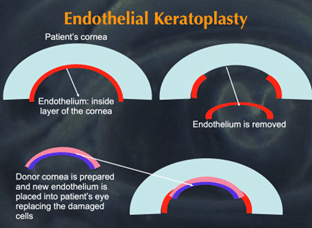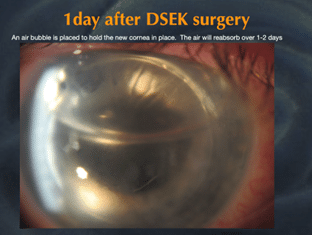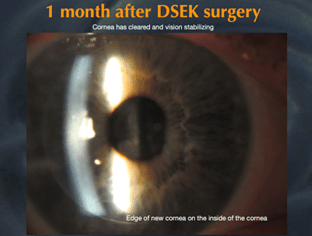Understanding Corneal Surgery: Penetrating Keratoplasty & Endothelial Corneal Transplants
The cornea is the clear front surface of the eye which help focus light into your eye. If the cornea becomes damaged by disease, injury, or degeneration it can create scarring. Often times a hard contact lens can help patients see but if the damage is too dense, corneal surgery may be required to restore vision. Two primary types of corneal transplants are penetrating keratoplasty (PK) and endothelial keratoplasty (EK).
Penetrating Keratoplasty (PK)
Penetrating keratoplasty, or full-thickness corneal transplant, involves replacing the entire cornea with a healthy donor cornea. This procedure is commonly performed for advanced keratoconus, corneal scarring, or severe corneal disease.
Key Features of PK:
- Replaces all layers of the cornea
- Suitable for severe corneal damage or scarring
- Longer healing time, often up to a year for full vision stabilization
- Higher risk of graft rejection compared to partial-thickness transplants
Endothelial Keratoplasty (EK)
Endothelial keratoplasty is a more advanced, minimally invasive approach that replaces only the innermost layer of the cornea (endothelium) while preserving the remaining healthy corneal tissue. There are two main types of EK:
- DSEK (Descemet’s Stripping Endothelial Keratoplasty): Transplants a thin layer of donor cornea, including the endothelium and a portion of stroma.
- DMEK (Descemet’s Membrane Endothelial Keratoplasty): Transplants only the endothelium and Descemet’s membrane, allowing for even faster recovery and better visual outcomes.

Key Features of PK:
- Faster recovery compared to PK, often within weeks to months
- Reduced risk of rejection due to selective tissue replacement
- Preferred for endothelial dysfunction conditions like Fuchs’ dystrophy
- Requires specialized surgical expertise


Choosing the Right Corneal Surgery
The choice between PK and EK depends on the specific condition of the cornea. Patients with widespread corneal damage may require a full-thickness transplant, while those with endothelial dysfunction may benefit from a more targeted endothelial transplant.
Advancements in corneal surgery continue to improve outcomes, making vision restoration safer and more effective. If you are experiencing vision loss due to corneal disease, consult with an ophthalmologist to explore your surgical options.
For more information or to schedule a consultation, contact our office today!

